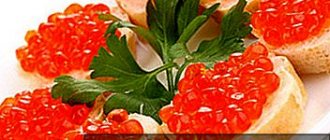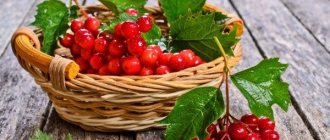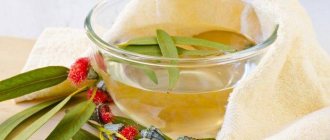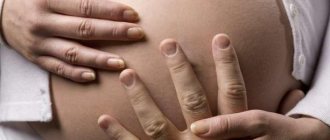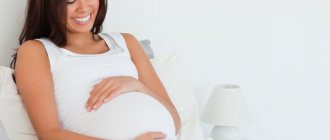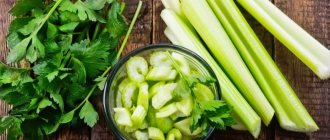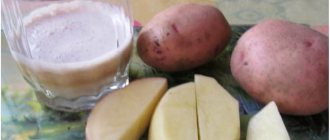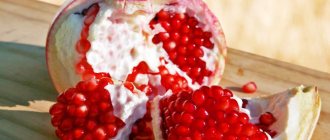The benefits of kelp (seaweed) during pregnancy
Enriching the body with vitamins and minerals is especially important for women during pregnancy, because their lack adversely affects the development of the fetus.
One of the necessary components during pregnancy is iodine (I), which seaweed is rich in.
Due to the many restrictions imposed on the diet of a pregnant woman, the following questions are relevant: how often can seaweed be consumed during pregnancy, in what quantity is kelp useful in early and late pregnancy, and during lactation?
Summing up
As you can see, the benefits of kelp are enormous. And excellent intestinal function and good heart function are its positive aspects. But the main thing is to worry about the baby and not to overeat this product. You shouldn't undereat either. If it is abused, serious problems will arise. After all, a large amount of iodine will harm the body.
It is also important to remember in what form to eat kelp. A canned dish will only do harm, because it does not have any beneficial properties for health. Therefore, either dried or fresh cabbage will do. Combine it with other dishes. A simple dish can be decorated with a few spoons of seaweed and will give it invaluable benefits, which the growing body of a future healthy child so needs.
Sea kale is a storehouse of vitamins for pregnant women
The specific taste of seafood can be repulsive, but to cover the daily requirement of the most important microelements for fetal development, it is enough to consume from 30 to 50 g of seaweed.
Table 1. Main composition of kelp.
| Vitamin/mineral | Content per 100 g (average value) | Daily value for humans | How much seaweed to consume to cover the daily requirement for a vitamin/mineral; average value, g |
| Bor | 312.5 mcg | 90 mcg | 28,8 |
| Bromine | 8200 mcg | 3170 mcg | 39 |
| Vanadium | 122.5 mcg | 52.2 mcg | 43 |
| Iodine | 385 mcg | 177 mcg | 45 |
| Silicon | 51 mg | 30 mg | 58 |
| Cobalt | 15 mcg | 10 mcg | 67 |
| Pectin | 3.6 g | 4.8 g | 133 |
| Arsenic | 11 mcg | 16 mcg | 145 |
| Folic acid | 180 mcg | 400 mcg | 220 |
| Strontium | 450 mcg | 1243 mcg | 276 |
Daily including 1-3 tbsp. A spoonful of cabbage in your diet can completely compensate for the need for iodine. In addition, seaweed contains:
- B vitamins (thiamine, riboflavin, pantothenic acid, pyridoxine, cyanocobalamin);
- vitamin K;
- calcium;
- magnesium;
- sodium;
- chlorine;
- cadmium;
- lithium;
- amino acids (up to 5% daily value);
- a small amount of fat, saturated fatty acids;
- sterols, carbohydrates, oxalic acid (up to 0.4% of the daily value).
Useful recommendations!
Seaweed accumulates both beneficial and harmful substances. Kelp collected in a region with unfavorable environmental conditions can cause harm to health. Heavy metals, radionuclides and other hazardous substances settle in such a product.
Helpful advice! You can conduct a simple experiment: add a small amount of potato starch to kelp intended for preparing a nutritious salad. Natural seaweed changes its color slightly: it takes on a bluish tint. The color of a low-quality product remains the same.
You need to carefully examine the packaging that contains frozen seaweed. High-quality kelp is painted in a rich dark green shade. Yellowed leaves indicate poor quality of the product. Preference should be given to seaweed, cut into neat strips. The thickness of a quality product is approximately 2 mm.
High-quality kelp should not contain harmful additives (preservatives E211 and E621). You should not buy seaweed, which is obtained in the Barents Sea: its waters are highly polluted.
What are the benefits of kelp for pregnant women?
Consumption of kelp is beneficial throughout the entire gestation period.
In the early stages
In the first trimester (from 1 to 13 weeks), iodine and folic acid are the most important microelements for normal fetal development and pregnancy maintenance.
In the early stages, the child’s thyroid gland is just developing, so there should be enough trace elements for the mother’s thyroid gland to function and for the proper formation of fetal tissue.
In a woman, the synthesis of the hormone T4 (free thyroxine) increases, and therefore the need for iodine increases. The expectant mother's kidneys work in an intensive mode, removing the incoming microelement from the body, which is why iodine deficiency occurs.
The main negative consequences of iodine deficiency during pregnancy:
- fetal freezing;
- involuntary termination of pregnancy;
- disruption of brain formation, and as a result - a decrease in the child’s intelligence in adulthood, in the worst case - cretinism;
- delayed puberty.
During the formation of the baby’s nervous, circulatory, reproductive system, musculoskeletal system, seaweed is a necessary product in the diet.
In the later stages
In the 2-3 trimesters, the development of the child’s organs continues. Iodine deficiency leads to pathologies of the thyroid gland and developmental delays.
From the 18th week of pregnancy, the fetal thyroid gland begins to produce hormones. If a woman is diagnosed with hypothyroidism (lack of production of the T4 hormone), the risk of pathologies of mental development and motor skills in the newborn remains high.
Nutritionists also recommend consuming kelp during pregnancy. Sea kale is low in calories, but rich in nutrients, so it is suitable for consumption by overweight women.
Before birth
Laminaria not only supports the body during pregnancy, but also helps the baby to be born.
The use of algae is common when the cervix is not adequately prepared for childbirth. Kelp sticks are introduced into the organ, which subsequently increase in size and promote the release of the hormone prostaglandin. As a result, labor begins, the cervix becomes softer, and its dilation begins.
During lactation
Sea kale is not an allergen, so it is not prohibited during lactation. It is necessary to introduce kelp into the diet gradually.
For the first 3 weeks after giving birth, it is important to follow a strict diet. At 4 weeks, mom can try 10 g of cabbage. If the child’s changes in the mother’s diet do not cause a negative reaction, you can increase the portion.
Usage
Kelp is used by pregnant women in several directions at once.
In gynecology
Thin sticks of dried kelp are a means of birth stimulation. They are used if by the end of pregnancy a woman has an immature cervix or the pregnancy is already post-term. The doctor inserts the sticks into the cervical canal of the cervix and leaves them there for several hours. The kelp swells and begins to mechanically expand the cervical canal from the inside, helping to soften the cervix and its rapid opening.
The use of such sticks causes a lot of controversy among doctors. According to some information, kelp increases the likelihood of infection of the uterine cavity after childbirth, its effect is quite painful for the mother in labor, and the desired effect is not always achieved. Therefore, some obstetricians consider its use unjustified and inappropriate, and some are very fond of administering kelp to pregnant women who cannot begin to give birth, and are very pleased with the results. The opinions of women in labor are also mixed.
For food
Sea kale can be available in different forms. A woman can buy seaweed frozen. Then they will need to be defrosted and washed very thoroughly. Dried seaweed is pre-soaked in clean water for 12-14 hours. A salad is prepared from the resulting product, added to fish soup, and added to side dishes.
But it’s better not to buy pickled cabbage canned in vinegar. Preservatives, sugar and additives will not benefit a pregnant woman, as will ready-made store-bought kelp salads.
The daily intake of seaweed for a pregnant woman is from 30 to 100 grams, no more.
In cosmetology
Soaked dry or thawed seaweed can be used to prepare homemade masks for the face and hands. A paste of them is an excellent anti-inflammatory local remedy for wounds, scratches and cuts.
What is best to combine with
Despite the specific taste of kelp, due to its high iodine content, when combining the product with other components, you can get savory, healthy dishes.
Salad with seaweed
To prepare it you will need:
- 50 g seaweed (pickled);
- carrots, beets, potatoes, cucumber - 1 pc. each vegetable;
- onion - 50 g;
- greens (parsley, onion, dill).
Dressing: 1 tbsp. lemon juice, 1 tbsp. l. olive (sunflower) oil; salt and pepper to taste.
Cut the cucumber and onion into small slices, boil and chop the remaining vegetables, finely chop the greens. Combine all ingredients with cabbage and mix, add dressing, salt and pepper. If you are prone to swelling, you should not add salt.
The components of the salad will not only compensate for the need for iodine, but will also improve blood counts and increase resistance to infectious diseases.
Seaweed salad with eggs and potatoes
To prepare the salad you need the following products:
- seaweed - 200 g;
- boiled peeled potatoes, boiled eggs - 2 pcs.;
- sautéed onion rings - 1 pc.;
- mayonnaise - 2-3 tbsp.,
- salt, pepper, sugar - up to ½ tsp.
All ingredients are cut into cubes and mixed with mayonnaise. Salt and pepper to taste.
It is advisable to prepare mayonnaise yourself by beating 1 egg yolk and 100 g of sunflower oil in a blender, pouring portions into the emulsion. The taste will be enriched with ½ tsp. lemon juice and the same amount of mustard, a pinch of salt and sugar.
During pregnancy, it is recommended to combine seaweed with raw or boiled vegetables, oil and mayonnaise-based dressings, add it to the filling when baking fish pie, and use it as a component for preparing rice with seafood.
Sea kale is a natural, easily digestible, low-calorie product and rich in microelements, therefore suitable for pregnant and lactating women. Like any food, it has contraindications, and its intake requires moderation, because any medicine used uncontrollably can be harmful. If you have hyperthyroidism or kidney dysfunction, taking foods high in iodine is contraindicated. The diet must be adjusted based on the results of laboratory tests and the recommendations of the endocrinologist.
The role of iodine in the body
Sea kale contains quite a lot of iodine. It is necessary for the proper functioning of the thyroid gland. Iodine takes part in energy metabolism and affects human mental activity. When eating foods rich in this microelement, performance increases, irritability disappears, and the condition of hair and teeth improves.
Iodine is present not only in seaweed, but also in the following foods:
- sea fish;
- chicken eggs;
- oysters;
- shrimps;
- persimmon;
- crabs;
- dairy products (ryazhenka, butter, cottage cheese).
With prolonged iodine deficiency in the body, the following complications may occur:
- infertility;
- developmental delay of the baby;
- fatigue;
- decreased performance;
- deterioration of thyroid function.
If medications containing iodine are used incorrectly, the body experiences an excess of the beneficial microelement. Oversaturation can also occur when eating large amounts of kelp, fish dishes, and persimmons. Iodine poisoning causes symptoms such as increased salivation, tinnitus, dizziness, runny nose, sore throat, unpleasant iron taste in the mouth, and fatigue.
Methods of use
Stores sell canned kelp in a filling with spices. It can be used as an addition to main courses or as part of salads. These can be salads with Korean carrots, fresh cucumbers, boiled eggs and onions. In large supermarkets you can buy frozen kelp or dry powder from it:
- Frozen seaweed is used in preparing first courses and salads. To do this, it is defrosted and washed; in this form it is ready for further use.
- Kelp powder is soaked in warm water in a ratio of 1:4 for one hour. Daily dose – 1 teaspoon of seaweed powder. The powder can be added to various dishes along with spices.
In cosmetology, the powder can be used to prepare ice cubes for the face or masks, which:
- cleanse problematic skin;
- relieve inflammation;
- normalize fat content.
Did you know? The benefits of kelp have been known for a long time, so it is not surprising that the product is included in the mandatory diet of all peoples living on the sea coast. A special decree issued by the Chinese government in the 13th century prescribed its mandatory use for every resident of the empire; in particular, pregnant women were required to consume at least 1 kelp leaf per day.
Application time – 0.5–1 hour. For joint pain, kelp masks with film wraps relieve pain and make joints more mobile. For diseases of the upper respiratory tract, chronic bronchitis and sore throat, the powder is used for inhalation. You can also rinse your mouth with it for sore throat, stomatitis, laryngitis, pharyngitis. Oral irrigation reduces the concentration of viruses during colds and promotes faster recovery. Careful planning of the diet during pregnancy is necessary to maintain the health of both the expectant mother and her baby. Knowing the benefits of kelp and appropriate precautions will help a woman during this difficult time.

